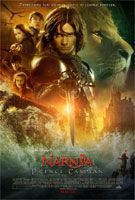The religious fervor and hype which attached itself to The Lion, the Witch, and the Wardrobe has burned itself out. You won’t see Prince Caspian shown at Church’s in place of Sunday sermons, they’ve already taken what they wanted from Narnia and now we’re simply left with the magic of C.S. Lewis’s imaginative, fantasy world. Whether or not he’s playing the Christ figure, Aslan still roars, and louder than ever.
More than any of the other “Narnia” books on which Disney’s movies have been or will be based, The Chronicles of Narnia: Prince Caspian is a war movie. Making what is essentially Narnia’s Saving Private Ryan work in the context of a PG rated family movie had to have been challenging, but director Andrew Adamson pulls it off by riding that PG rating right to the edge. In the process, Narnia loses some of the innocence and wonder that buoyed along the first film, but replaces it with carefully thought out meditation on what it really means to grow up.
This time, it doesn’t start with the Pevensie children, but with a young Prince driven out of his castle by a power mad uncle Miraz. This is Prince Caspian, and in a moment of desperation he blows a magic horn which summons the Pevensies back to the magic land they left. The Narnia we knew from the first film is gone, and while it’s only been a year for the Pevensie kids, it’s been 1500 in Aslan’s land. Humans have invaded, murdered and sent into hiding the world’s magical creatures, and left it a much darker place. When Peter, Susan, Edmund, and Lucy arrive they discover everyone they’ve known there is long since dead, but they set about helping Prince Caspian unite Narnia’s surviving dwarfs, centaurs, talking badgers, and other magical things into an army to fight off Miraz and his hordes of Tellamarines.
New additions like Peter Dinklage as the dwarf Trumpkin, Ben Barnes as Caspian, and a computer animated warrior mouse named Reepicheep really carry the cast. Dinklage, despite his size, almost seems like too good an actor to waste on the usual dwarven prosthetic stuff other diminutive performers are forced into. Yet on the other hand it’s nice to have someone playing a Dwarf who is not only the right size, but can actually act. The kids are still, well, kids. They aren’t a bunch of Haley Joel Osments, which means they come with all the child actor awkwardness you have to expect. At least they aren’t acting robots.
For me, the biggest improvement over the last film comes in the form of special effects. They’ve fixed the problems of Wardrobe and delivered seamless CGI for this one, there’s none of the jarring awkwardness and clipping of the previous movie. It works particularly well in the big action sequences. On the other hand, some of the action may seem overly familiar. It’s no one’s fault really, but many of the big moments in the book bear a striking resemblance to some of the things we’ve already seen in Lord of the Rings. Anyone who’s a fan of Peter Jackson’s movies will find it impossible not to compare the massive battle sequences in this one to Helm’s Deep in Two Towers, or to compare the movie’s big river finale to Arwen’s battle with the Nazgul in Fellowship. It can’t be helped, and Adamson does as much as he can to differentiate these similar action beats from those we’ve already seen in Rings.
The Chronicles of Narnia still lacks some of the subtly and complexity of the fantasy genre’s best entries, but Adamson continues to deliver a solid, enjoyable adaptation of C.S. Lewis’s work. This is a family movie after all, and Narnia stays rooted in its brightly colored world where good wins over evil, a badger can be your best friend, and God is a ferocious, yellow-maned lion.
Most Popular




